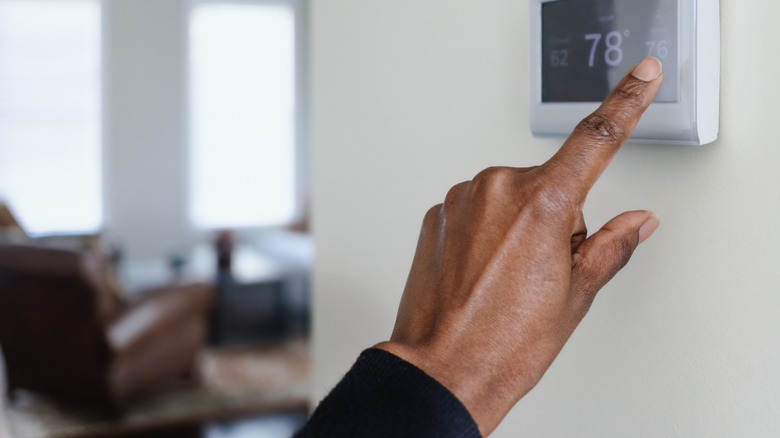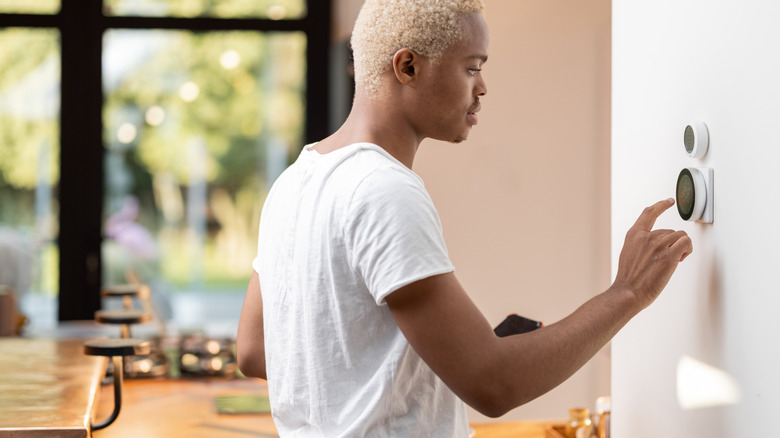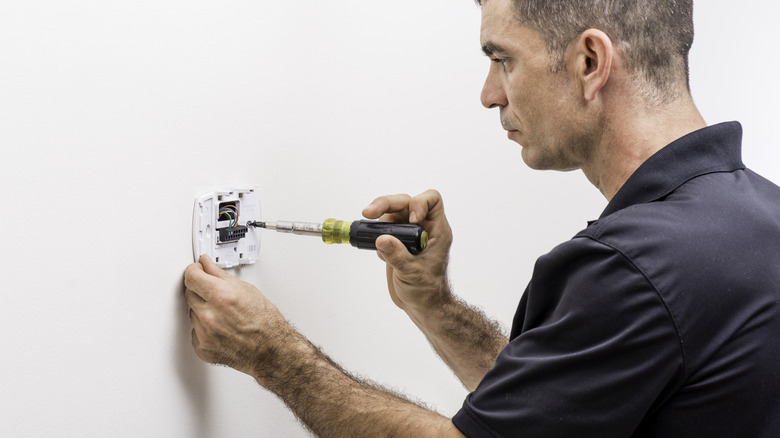Your Thermostat's Location May Be Seriously Costing You Money
It's frustrating when you set your thermostat to a reasonable temperature and still face sky-high electric or fuel bills. You try to be energy-conscious, layering clothes, using fans, and choosing ideal thermostat settings for each season, but your bills don't reflect your efforts. There is one thing that may be contributing to those high bills that you've overlooked: the location of your thermostat.
The reason your thermostat's spot in your home might be responsible for your high bills is that it's only measuring the temperature of the area directly around it. If that area doesn't reflect the overall temperature of your home, it won't be an accurate gauge for the thermostat to keep the house comfortable in general. Pockets of higher or lower temperatures or lack of airflow could affect the reading. So, if it's in the hallway, it will relay the temperature of only your hallway to your furnace or air conditioning system, potentially causing it to run excessively or switch off too soon. Each time your heating or cooling system kicks on and off due to an inaccurate home temperature reading, it costs you money.
In the hallway thermostat example, if the thermostat is set to 73 degrees Fahrenheit and the temperature in the hallway reaches 74 degrees, the air conditioner will activate throughout the house. However, since hallways often have poor airflow, the cool air won't reach the thermostat immediately, causing the air conditioner to run excessively until the air around the thermostat finally cools. If the thermostat is near a cooling vent, the air will cool very quickly, causing the system to shut off before the rest of the house cools. In both of these scenarios, money is wasted, and your home isn't at the desired temperature.
The worst and best places for a thermostat
Other than remote hallways, there are other places in your home where a thermostat will often give off inaccurate readings, or what HVAC experts call ghost readings. Thermostats located on exterior walls or near windows and doors, hot water pipes, wood stoves, and fireplaces can cause ghost readings — those structures can affect the temperature near the thermostat, giving an inaccurate measure of the home's temperature. If your thermostat is positioned too closely to the floor, near a vent, or in direct sunlight, its temperature readings may also be inaccurate. Entryways and stairways are also poor spots for a thermostat due to the lack of airflow. Finally, if your thermostat is located in your kitchen, where temperatures fluctuate and significant heat sources are present, that will also trigger ghost readings.
Your heating and cooling systems will function most efficiently when your thermostat is located on an interior wall in a regularly used room, away from any sources of heat or cold. Since hot air rises, if you have a two-story home that uses a single thermostat, it should be located on the first floor. The ideal room for thermostat placement is the living room, since it is used often and generally has better air circulation than other rooms. A spot on your interior living room wall, away from doors, windows, direct sunlight, and your fireplace is the best place to get a thermostat reading that will keep you comfortable and save you money.
What to do if your thermostat is improperly placed
If you think the placement of your thermostat might be behind your high electric bills, you have some options. The first is to move your thermostat to a more suitable area. This can be something you do yourself, provided the thermostat needs to be moved less than 18 inches in either direction on the same wall or less than 10 feet on the wall opposite of it. If it needs to be moved further than that or into a different room, you will need to have a licensed technician handle the job. That's because the wiring changes can be complex.
If you still have a traditional thermostat, you might hire an HVAC technician to install a smart thermostat equipped with temperature sensors. The benefit of smart thermostat systems is that when you place temperature sensors in areas around your home that aren't considered hot or cold spots, the sensors communicate with the main thermostat to provide a more accurate overall view of your home's temperature. Your smart thermostat can be set to heat or cool your home based on the temperature readings in every zone with a sensor, helping to maintain a more even heating and cooling distribution throughout your home. Although a smart thermostat and sensor system can cost a lot to install upfront, especially considering installation costs, it can help you save money in the long term.


